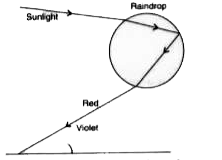(a) Describe an activity along with a labelled diagram the phenomenon of dispersion through a prism.
(b) Explain in brief the formation of rainbow with the help of figure.
(a) Place a prism on a white sheet of paper with the triangular face on the sheet and trace its boundary ABC.
(i) Fix two pins T and S on one side.
(ii) Place the prism on the boundary ABC.
(iii) Looking through the other side fix two more pins Q and R in such a way that the all four pins appear to be in the same line.
(iv) Remove the pins and mark their positions.
(v) Join TS and RQ and extend them to meet the faces of the prism at P and O respectively.
(vi) Join PO.
(vii) TP represents the incident ray.
(viii) PO represents the refracted ray.
(ix) And OR represents the emergent ray which is bent towards the base.
(x) Let PN and ON be the normal at the points P and O respectively.
(xi) And let i be the angle of incidence and r the angle of refraction.
(xii) If the incident ray TP is extended forward and the emergent ray RO backwards, they meet at M, forming the angle OML.
(xiii) Measure the angle OML.
(xiv) This angle is called the angle of deviation.
(xv) Angle of deviation is the angle through which an incident ray deviates.
(xvi) Repeat this for different values of angle of incidence.

PE - Incident ray∠i−Angle of incidenceEF - Refracted ray∠r−Angle of refractionFS - Emergent ray∠e−Angle of emergence∠A−Angle of the prism∠D−Angle of deviation
(b) Rainbow forms when sunlight hits the water droplets suspended in the atmosphere and undergoes total internal reflection. When the sunlight comes out of the drop it disperses, where the drop acts like a small prism.
This dispersion or breaking up of light into several colours forms the Rainbow.

Topper's Solved these Questions
- THE HUMAN EYE AND THE COLOURFUL WORLDBook:OSWAAL PUBLICATIONChapter:THE HUMAN EYE AND THE COLOURFUL WORLDExercise:NCERT CORNER (INTEXT QUESTIONS)
Explore 4 Videos
- THE HUMAN EYE AND THE COLOURFUL WORLDBook:OSWAAL PUBLICATIONChapter:THE HUMAN EYE AND THE COLOURFUL WORLDExercise:NCERT CORNER (TEXTBOOK EXERCISES)
Explore 13 Videos
- THE HUMAN EYE AND THE COLOURFUL WORLDBook:OSWAAL PUBLICATIONChapter:THE HUMAN EYE AND THE COLOURFUL WORLDExercise:TOPIC - 2 (REFRACTION OF LIGHT AND DISPERSION) (SHORT ANSWER TYPE QUESTIONS - II)
Explore 15 Videos
- SSLC KARNATAKA TOPPERS' ANSWERS MARCH -2018Book:OSWAAL PUBLICATIONChapter:SSLC KARNATAKA TOPPERS' ANSWERS MARCH -2018Exercise:QUESTION
Explore 10 Videos
Similar Questions
Describe the formation of rainbow in the sky with the help of a diagram.
View SolutionWhat is meant by dispersion of white light ? Describe the formation of rainbow in the sky with the help of a diagram.
View SolutionExplain in brief biogas production process with the help of a labelled figure.
OR
What is biogas? Write in brief about the production process.
View SolutionDescribe the reflex action with the help of labelled diagram.
View SolutionWhat is a rainbow ? Draw a labelled diagram to show the formation of rainbow.
OR
Describe the formation of rainbow in the sky with the help of a diagram.
View SolutionExplain the cause of dispersion of white light through a prism.
View SolutionExplain how spectrum is formed by a prism with the help of a diagram.
View SolutionDraw a labelled ray diagram to show the formation of a rainbow.
View SolutionDescribe the histology of testis with help of labelled diagram.
View SolutionExplain the phenomenon of dispersion of white light through a glass prism, using suitable ray diagram.
View Solution

